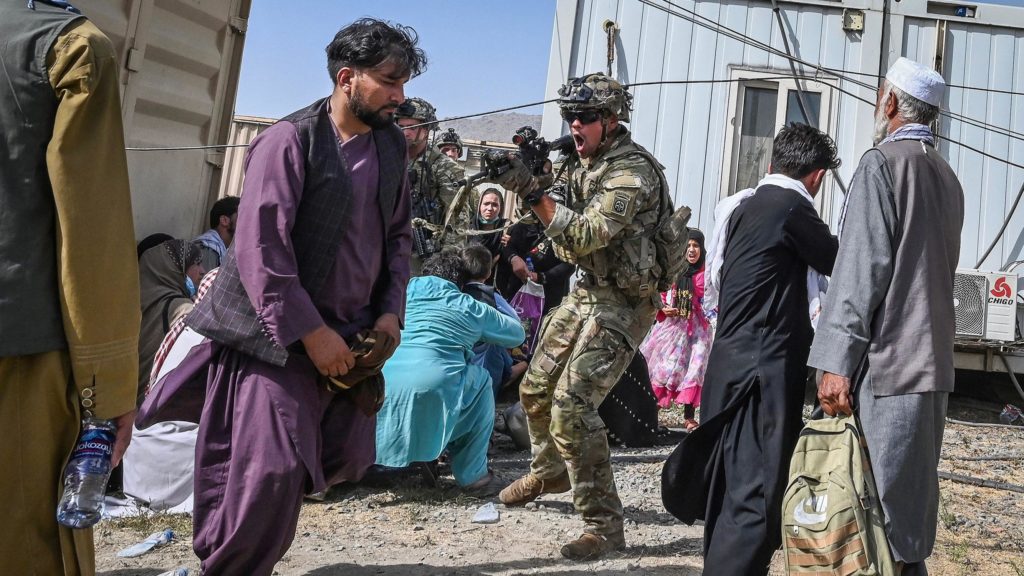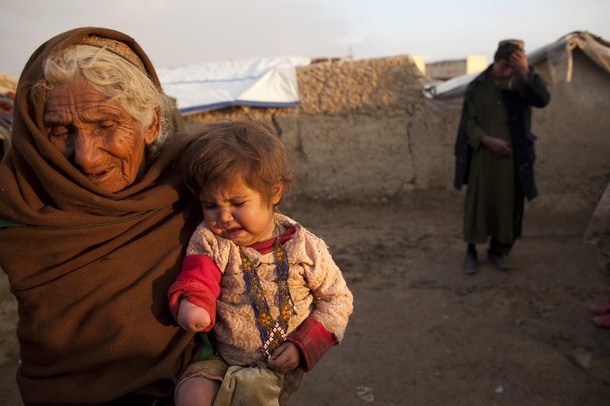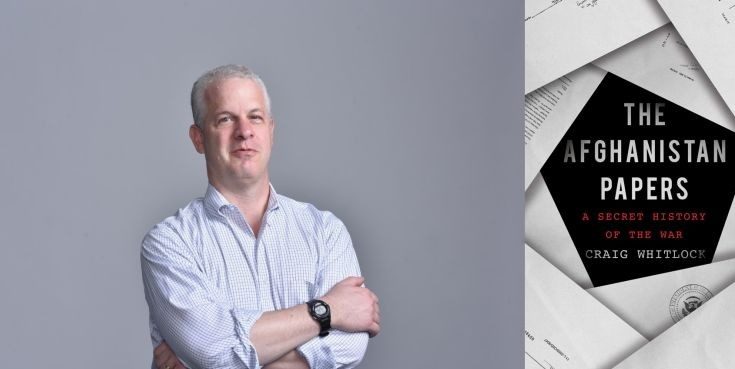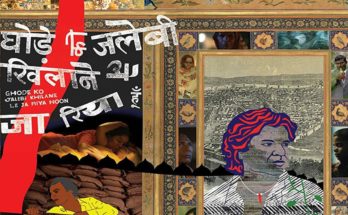Joe Biden did not begin the Big Botch-Up in Kabul. George W Bush started it all, and Barack Obama and Donald Trump continued the golden legacy. Backed by the top brass of the political and war machine of the American establishment. A journalistic bombshell of our times, a new book of scathing revelations by a seasoned investigative reporter of The Washington Post, exposes it all.
(‘The Afghanistan Papers: a Secret History of the War’, by investigative journalist Craig Whitlock)

George W Bush, president of the United States during the 9/11 terrorist attacks on America, and the man who started the original ‘war against terror’, did not apparently know the name of his own supreme commander in the ‘war’ in Afghanistan. Not only that, he simply could not ‘make time’ to meet him – seemingly, so skewed were his priorities.
Earlier, The New York Times had reported (September 19, 2001): Speaking with unusually raw intensity, President George W Bush says that he wants the militant Islamic leader Osama bin Laden brought to justice “dead or alive”… “There are no rules,” Mr Bush said during a visit to the Pentagon. “It’s barbaric behavior. They slit throats of women on airplanes in order to achieve an objective that is beyond comprehension, and they like to hit and then they like to hide out… But we’re going to smoke them out,” he said… His comments appeared in part spontaneous, reflecting a rage that seems to have been building for days, and that aides say was stoked by the horror he witnessed Friday on his visit to New York. “I want justice,” he said. “There’s an old poster out West that said, ‘Wanted, dead or alive.’”
(In one chilling discovery reported by The New York Times, the body of a male air crew member from one of the planes that struck the World Trade Center was found in the rubble bound hand and foot, and the body of a flight attendant was found with her hands bound.)
Two years later, his Defense Secretary, Donald Rumsfeld, in a memo to his intelligence chief, actually admitted that he simply had “no visibility into who the bad guys are”. This was two years after the formidable American war machine had unleashed its full might inside the landlocked country. Not to be outdone, his successor, Robert Gates, said later: “We didn’t know jack shit about Al-Qaeda.”
On the war in Afghanistan, complained Army General Dan McNeill, “There was no campaign plan. It just wasn’t there.” The officer had operated ‘twice’ as the US commander under the Bush administration.
“There was no coherent long-term strategy,” said David Richards, a British General who led US and NATO forces from 2006 to 2007. “We were trying to get a single coherent long-term approach — a proper strategy — but, instead, we got a lot of tactics.”
Other military officials claimed that the Americans “flubbed the war from the start, committing missteps on top of miscalculations on top of misjudgments”.
“We did not know what we were doing,” said Richard Boucher, Bush administration’s top diplomat for South and Central Asia.
“We didn’t have the foggiest notion of what we were undertaking,” said Army Lt. Gen. Douglas Lute. He was the ‘White House War Czar’ under Bush and Barack Obama.
Obama promised to end the war, like Bush had done earlier, with much fanfare. Hence, NATO and American officials held a ceremony in Kabul to mark the occasion.
“A multinational colour guard paraded around as music played. A four-star general gave a speech and solemnly cased the green flag of the US-led international force that had flown since the beginning of the conflict.”
Obama called the day “a milestone for our country”. He said that America was now safe and more secure after 13 years of war. “Thanks to the extraordinary sacrifices of our men and women in uniform, our combat mission in Afghanistan is ending, and the longest war in American history is coming to a responsible conclusion,” he declared.
In a bizarre statement stretching scientific logic to its limits, Army General John Campbell, 57, commander of the US and NATO forces, asserted that since the start of the war, ‘life-expectancy’ for the ‘Average Afghan’ had increased by 21 years. “You time that by about 35 million Afghanis represented here in the country, that gives you 741 million years of life,” he announced.
Writes Craig Whitlock, investigative reporter of The Washington Post:
But for such a historical day, the event seemed strange and underwhelming. The president didn’t actually attend; Obama issued his remarks in a written statement from Hawaii while he relaxed on vacation. The military ceremony took place in a gymnasium, where several dozen people sat on folding chairs. There was little mention of the enemy, let alone an instrument of surrender. Nobody cheered.
SEASONED JOURNALISTS KNOW about the Pentagon Papers on the Vietnam, a war where the mightiest military empire lost a protracted and bloody battle with the guerilla forces of one of the smallest countries in the world. The world also knows about ‘Deep Throat and the Watergate Scandal’ with then US President Richard Nixon as the protagonist, while two intrepid journalists chased the story with incredible grit and maturity. Now, we have an explosive and exclusive investigation and expose of the Afghanistan war, which documents and exposes unprecedented goof-ups and confessions of failure at the topmost levels, and at such a massive scale, that the entire ‘American Empire’ seems to be so hollow and crumbling after a two-decade war.
It seems so shallow and rusted within, that all the war rhetoric, muscle-flexing, chest-thumping and money power seems such a big fake. In the final instance, it all turned out to be an infinite wasteland of human resources, over a graveyard of dead bodies and dead dreams, scattered across the rugged expanse of Afghanistan, from Kabul to Kandahar, and Herat to Helmand. Even while the Taliban is back once again, with the US playing footsie and Pakistan back as the behind-the-stage king-maker.
‘The Afghanistan Papers: a Secret History of the War’, by investigative journalist Craig Whitlock, has thoroughly and totally exposed the American political, defense and war machine! It has laid bare the lies, half-truths, propaganda and subterfuge hatched by the formidable Pentagon top brass and White House, the top military and strategic big guns, their sundry underlings, the huge parasitic networks of entrenched industrialists, arms-dealers and manufacturers, contractors, mercenaries and miscellaneous cartels, the embedded journalists and propaganda machinery — and all this under the watch of successive presidents: George W Bush, Barack Obama, Donald Trump. And let us not even count the billions and trillions which apparently went down the drain in Kabul and beyond – so where did it all go?
If Joe Biden has inherited the glorious ruins of a grand botch-up, then all the war medals for this apocalypse now should go to his illustrious predecessors. Clearly, the 20-year-old Afghan War has been perhaps the biggest foreign policy and strategic/military disaster for a hegemonic and imperialist war machine which has inflicted violence and destruction across the Post-War global landscape to reassert again and again its dominant narrative of supremacist, military and capitalist power, driven by the insatiable greed of its profit industry of construction, destruction and reconstruction, even while ‘blood for oil’ became the principle doctrine of war in the Middle-East in recent times.
First publishedin parts by The Washington Post in 2019, ‘The Afghanistan Papers’ should rattle the American State and superstructure, its much-touted beliefs in democracy and truth, and all its shaky skeletons in the cupboard. More than that, it should shatter the ethical conscience and public consciousness of the American civil society.
This is because these disclosures prove with evidence, often straight from the horses’ mouths, of how the top army and political brass, led by various US presidents, have made a fool of the American people by manipulating public opinion through a continuous and organized web of lies and deception, fake and doctored news, and official declarations, speeches, text and rhetoric.

The sensational hardback edition, running into 346 pages with meticulously documented endnotes and references, has been published by Simon and Schuster. It has been launched globally on August 31, 2021. It is already creating waves.
Craig Whitlock is a seasoned journalist and investigative reporter with The Washington Post. He has reported from more than 60 countries across the world. He has been a beat reporter for seven years covering the Pentagon and US military. Earlier, he has been a foreign correspondent for the newspaper covering Al-Qaeda, terrorism and conflict zones in the Middle-East, Pakistan, North Africa and Europe. He has seen the “mess” in Afghanistan upfront while covering at least four defense secretaries and several war commanders.
For his reportage on Afghanistan, he has received the George Polk Award for Military Reporting, the Scripps Howard Award for Investigative Reporting, the Investigative Reporters and Editors Freedom of Information Award, and the Robert F Kennedy Journalism Award for international reporting. He has been a three-time finalist for the Pulitzer Prize.
“Like many journalists, I knew Afghanistan was a mess…” he writes. “…But I wondered if everyone had missed the big picture.”
His book starts with an important quote as a prelude, recording a historic moment for independent and ethical journalism in the US, and across the world, and as a tribute to journalists who chose to stand against the establishment if need be, and to tell the truth on the ground, against all odds. “Only a free and unrestrained Press can effectively expose deception in government. And paramount among the responsibilities of a free Press is the duty to prevent any part of the government from deceiving the people and sending them off to distant lands to die of foreign fevers and foreign shot and shell.”
This is a statement by Justice Hugo L. Black of the US Supreme Court, in the New York Times Co. v. United States, also known as the ‘Pentagon Papers Case’, June 30, 1971. In a 6–3 decision, the court ruled that the US government could not block The New York Times or The Washington Post from publishing the Defense Department’s secret history of the Vietnam War.
Over several years of painstaking and meticulous investigations, Whitlock has obtained thousands of documents, oral testimonies, official memos and notes, interviews, published and unpublished testimonies, confessions and statements, often expressed directly by the top brass of the American power and military apparatus. In page after page, chapter after chapter, this book is a bitter revelation and a scathing indictment of a bloated regime which prides itself as the most powerful State apparatus in the world, while self-congratulating America as the “greatest nation in the world” — for mythical reasons it alone knows.
Writes Whitlock, about what has been a fake narrative repeated again and again as a public spectacle: “President Barack Obama had vowed to end the war and bring all the troops home, but he failed to do so as his second term neared an end in 2016. Americans had grown weary of endless conflict overseas. Disillusioned, many people stopped paying attention…”
Indeed, like the fake ceremony described above, replete with typical ‘Obamesque’ charm and deception, it was crystal-clear that both, the US president and his top general, were playing a stage-managed show with a lot of pomp and patriotism thrown in. The damned, bloody war was nowhere ending. Afghan and American troops and civilians would continue to die for many years to come, as it happened in ravaged Syria in the following years.
This reporter covered the American elections in 2016 from New York and Boston. One of the reasons the young, educated pro-Bernie Sanders millennials hated Hillary Clinton was because of a certain video which had circulated widely during the 2016 presidential polls. It showed her devilish and unbridled ecstasy when shown how Muammar Gaddafi, soaked with blood all over, has been captured, beaten into pulp and tortured on the streets, and then bayoneted to death in perhaps one of the most grotesque and brutal forms of ‘mob-lynching as justice’ awarded to a former head of state.
(In Syria, for instance, a mindless and multi-pronged war by multiple actors, continued, from Damascus and Alleppo and beyond. This mindless war left millions dead, brutalised, trafficked and devastated, turned cities into morbid installations of melted, destroyed rubble, forced women such as from the Yazidi community into dehumanizing sex slavery at the hands of Islamic fundamentalists, and gave rise to another sinister ‘Caliphate’ – the ISIS — backed by all kinds of sinister forces and diabolical players from behind the infinite war rubble in the Middle-East. This was a war first conceived and crystallized by Secretary of State Hillary Clinton (then the next presidential hopeful, backed by an ‘anti-war’ Obama). Barack Obama had earlier received a Nobel Peace Prize much too early in his presidency even as the world rejoiced the arrival of the first black president in the history of the United States.)
Writes Whitlock: “The Washington Post and other news organizations had exposed systemic problems with the war for years. Books and memoirs had delivered insider accounts of pivotal battles in Afghanistan and political infighting in Washington. But I wondered if everyone had missed the big picture… How had the war degenerated into a stalemate with no realistic prospect for an enduring victory? The US and its allies had initially crushed the Taliban and Al-Qaeda in 2001. …What went wrong? No one had conducted a thorough public accounting of the strategic failures or provided an unsparing explanation of how the campaign fell apart. To this day, there has been no Afghanistan version of the 9/11 Commission, which held the government responsible for its inability to prevent the worst terrorist attack on American soil. Nor has Congress convened an Afghanistan version of the Fulbright Hearings, when senators aggressively questioned the war in Vietnam. With so many people from both parties responsible for a multitude of errors, few political leaders have wanted to assign or accept blame…”
In the summer of 2016 Whitlock received a “news tip that an obscure federal agency, the Office of the Special Inspector General for Afghanistan Reconstruction, or SIGAR, had interviewed hundreds of participants in the war and that many had unloaded pent-up frustrations” in a project called ‘Lessons Learned’. This project was meant to “diagnose policy failures in Afghanistan”.
Only a free and unrestrained Press can effectively expose deception in government. And paramount among the responsibilities of a free Press is the duty to prevent any part of the government from deceiving the people and sending them off to distant lands to die of foreign fevers and foreign shot and shell.
(Justice Hugo L. Black of the US Supreme Court, in the New York Times Co. v. United States, also known as the ‘Pentagon Papers Case’, June 30, 1971)
According to Whitlock, “That September, SIGAR began to publish a series of Lessons Learned reports that highlighted problems in Afghanistan. But, the reports, weighed down with leaden government prose, omitted the harsh criticism and finger-pointing that I heard the interviews contained. An investigative journalist’s mission in life is to find out what truths the government is hiding and reveal them to the public… So I filed Freedom of Information Act requests with SIGAR seeking transcripts, notes and audio recordings of the Lessons Learned interviews. I argued (that) the public had a right to know the government’s internal criticisms of the war — the unvarnished truth…
“At every turn, SIGAR delayed and resisted the requests — a hypocritical response for an agency that Congress had created to provide accountability for the enormous sums of taxpayer dollars being spent on the war. The Post had to file two federal lawsuits to compel SIGAR to release the Lessons Learned documents. After a three-year legal battle, SIGAR finally disclosed more than 2,000 pages of previously unpublished notes of interviews with 428 people who played a direct role in the war, from generals and diplomats to aid workers and Afghan officials. The agency redacted portions of the documents and concealed the identities of most of the people it interviewed. But the interviews showed that many senior US officials privately viewed the war as an unmitigated disaster, contradicting a chorus of rosy public statements from officials at the White House, the Pentagon and the State Department, who assured Americans year after year that they were making progress in Afghanistan…”
Among other documents, interviews and oral testimonies, Whitlock also obtained hundreds of classified memos about the war in Afghanistan that Defense Secretary in the Bush administration, Donald Rumsfeld, dictated or received between 2001 and 2006. They were called ‘snowflakes’ by Rumsfeld and his staff; these included “brief instructions or comments that the Pentagon boss dictated to his underlings”, often many times a day.
“…Speaking frankly because they assumed their remarks would not become public, US officials confessed to SIGAR that the war plans had fatal flaws and that Washington had wasted billions of dollars trying to remake Afghanistan into a modern nation. The interviews exposed the US government’s botched attempts to curtail runaway corruption, build a competent Afghan army and police force, and put a dent in Afghanistan’s thriving opium trade. Many of those interviewed described explicit and sustained efforts by the US government to deliberately mislead the public. They said officials at (the) military headquarters in Kabul — and at the White House — routinely distorted statistics to make it appear (that) the United States was winning the war when that was plainly not the case…”
In the chapter, ‘Afghanistan Becomes an Afterthought’, Whitlock writes how Bush and Obama heralded the end of the war as a public relations exercise, though it was all stage-managed and fake.
“Six weeks after the invasion of Iraq, on May 1, 2003, the commander-in-chief boarded another flight to deliver another victorious speech with a military audience as the backdrop… Thousands of sailors cheered as Bush stepped off the plane and exchanged salutes with crew members on the flight deck. The president mingled and posed for photos before changing into a civilian business suit to give his speech as the sun dipped over the Pacific Ocean. Standing in front of a billowing red-white-and-blue banner proclaiming ‘Mission Accomplished’, Bush announced that ‘major combat operations have ended’ and thanked the US military for ‘a job well done’ in Operation Iraqi Freedom… In fact, the worst in Iraq was yet to come and Bush’s visit to the aircraft carrier would haunt him as the biggest public-relations blunder of his presidency…It also overshadowed an equally nonsensical claim that his defense secretary had made hours earlier about the war in Afghanistan…”

In a joint press conference with Hamid Karzai in Kabul, Rumsfeld echoed the ‘Bush script’, that major combat operations are over in Afghanistan. “The bulk of this country today is permissive, it’s secure,” he said.
Whitlock reports: “But, as in Iraq, the fighting in Afghanistan was far from over. Combat operations would re-intensify and turn much more deadly. More than 95 per cent of US casualties in America’s longest war had yet to occur. In oral-history interviews, Army officers who served in Afghanistan in 2003 said Rumsfeld’s assertion that combat had ended was absurd.
‘We used to laugh,’ said Lt. Col. Mark Schmidt, a Special Forces officer with a background in psychological operations. ‘There was still plenty of fighting going on… Quite frankly, we were just going around killing people. We’d fly in, do a mission for a few weeks, then we’d fly out —and, of course, the Taliban would just flow right back in…’”
Whitlock writes: “..Most U.S. officials wrongly assumed the Taliban would never pose a serious threat again. In his ‘Mission Accomplished’ speech, Bush declared flatly: ‘We destroyed the Taliban.’”
In the chapter, ‘At War with the Truth’, Whitlock writes that during his trip in 2012 to Afghanistan, 73-year-old CIA director, Leon Panetta, apart from other PR disasters, had to deal with a massacre, typically something insane, which has been repeated again and again in different forms, in similar wars – from Vietnam to Afghanistan, from Iraq to Syria and Palestine. Even recently, after the bomb blast at the Kabul Airport which killed scores of civilians, Taliban guard and US Marines, the drone attack by the Americans reportedly killed an entire Afghan family in Kabul. This war had too many similar stories of innocents dying all over at the hands of the Taliban, other terrorist groups, and the US and NATO forces.
“A few days before his arrival, a lone US soldier, Staff Sgt. Robert Bales, strode into two Afghan villages in Kandahar province in the middle of the night and inexplicably massacred 16 sleeping villagers, most of them women and children. The mass murder inflamed Afghans and the Taliban exploited it as propaganda fodder…,” reports Whitlock.
Panetta termed his visit in the backdrop of this massacre as “very encouraging”. The campaign, as I’ve pointed out before, I think, has made significant progress,” he told reporters in Kabul. “We’re on the right path. I’m absolutely convinced of that.”
The Obama administration followed this bluff and bluster with distorted statistics very similar to what the Bush administration had reportedly done earlier. According to Whitlock, Obama’s staffers in the White House, the Pentagon and the State Department took this hyperbole of distortion to an entirely new level — “hyping figures that were misleading, spurious or downright false”.
Writes Whitlock:
“‘We have broken the Taliban’s momentum,’ Secretary of State Hillary Clinton told a Senate committee in June 2011. As evidence, she quoted an array of metrics: Afghan schools had enrolled 7.1 million students, a seven-fold increase since the fall of the Taliban; infant mortality had decreased by 22 per cent; opium production was down; hundreds of thousands of farmers had been ‘trained and equipped with new seeds and other techniques; and Afghan women had received more than 100,000 micro-finance loans’…”
“Now, what do these numbers and others that I could quote tell us?” said Hillary Clinton. “Life is better for most Afghans.”
In contrast, much later, auditors discovered “many of the statistics” dished out on life-expectancy, enrolment in schools, infant mortality, among other human development index, was based “on inaccurate or unverified data”.
The special inspector general for Afghanistan reconstruction, John Sopko, later told the Congress in January, 2020 that officials “knew the data was bad” and yet chose to exaggerate — “bragged about the numbers anyway”. Sopko said the lies were part of “an odor of mendacity” that was integral to the depiction of the war by the US adminstration, writes Whitlock.
The investigations found that in the interviews recovered from the project, ‘Lessons Learned’, military officials and advisers made extra efforts to systematically mislead the American public. Apparently it was routine tactics at the military headquarters in Kabul, at the Pentagon and at the White House, to skew statistics so as to prove that the US was actually winning the war, though this was not the reality on the ground.
In one such interview, an army colonel, Bob Crowley said, “Every data point was altered to present the best picture possible.” He was a senior counter-insurgency adviser to US commanders in 2013 and 2014.
“Surveys, for instance, were totally unreliable but reinforced that everything we were doing was right and we became a self-licking ice cream cone,” he said.
“At military headquarters, “truth was rarely welcome” and “bad news was often stifled,” Crowley said. “There was more freedom to share bad news if it was small — we’re running over kids with our MRAPS (armoured vehicles) — because those things could be changed with policy directives. But when we tried to air larger strategic concerns about the willingness, capacity or corruption of the Afghan government, it was clear it wasn’t welcome.”
Interestingly, and funnily, John Garofano, a Naval War College strategist, who advised the Marines in Helmand in 2011, disclosed that a huge amount of time and effort was spent in “churning out color-coded charts that heralded positive results”. “They had a really expensive machine that would print the really large pieces of paper like in a print shop,” he said in a Lessons Learned interview. “There would be a caveat that these are not actually scientific figures, or this is not a scientific process behind this.”
Donald Trump fought the presidential elections in 2016 on the patriotic ploy of ‘America First’ and ‘Make America Great Again’ unleashing racist and white supremacist currents, an inherited brand of hate politics and collective phobia of immigrants, as well as promising to back-out of all the wars in which America has been trapped in other parts of the world.
Whitlock depicts an ironic study which reflects how frivolous and risky it all became when it came to Trump. “Before he won the 2016 presidential election, the real-estate mogul and reality TV star had complained loudly about the war’s expense and demanded that Obama pull out. In keeping with his slogan, ‘Make America Great Again,’ he denounced any foreign-aid programmes that resembled nation-building… ‘Afghanistan is a complete waste. Time to come home! — he tweeted in 2012. We have wasted an enormous amount of blood and treasure in Afghanistan. Their government has zero appreciation. Let’s get out! — he tweeted in 2013. A suicide bomber has just killed US troops in Afghanistan. When will our leaders get tough and smart. We are being led to slaughter! — he tweeted in 2015…’”
However, once Trump assumed power in January 2017, he ran into serious difficulties. His aides in the cabinet and the Pentagon top brass told him in as many words that “it could be cataclysmic to withdraw abruptly. If the Afghan government collapsed or the war spilled over to nuclear-armed Pakistan, he would own the problem,” they told him.
“Trump agreed,” writes Whitlock. “However, unlike other presidents, he had scant respect for the generals running the war and no patience for detailed policy deliberations…Trump hated any hint of weakness or defeat. His Defense Secretary, James Mattis, had committed the grievous error of suggesting just that in June when he told the Senate Armed Services Committee that ‘we are not winning in Afghanistan right now’. General Joseph Dunford Jr., the chairman of the Joint Chiefs of Staff, made the same mistake six days later when he confessed during an appearance at the National Press Club in Washington that ‘Afghanistan is not where we want it to be’.”
Citing an interesting event which tells a typical story so characteristically Trump, Whitlock reports that the president was invited to the Pentagon by Mattis for a “wide-ranging discussion about the importance of NATO and other military alliances…” Trump agreed, but was fed up with the lecture soon enough.
“In particular, he blew his stack when Mattis and Dunford talked about Afghanistan. Trump called it a ‘loser war’. He trashed the commanding general in Kabul, Army General John Nicholson Jr., saying: ‘I don’t think he knows how to win… I want to win…’”
According to Washington Post journalists Philip Rucker and Carol Leonnig, Trump said in the meeting: “You’re a bunch of dopes and babies.”
Indeed, The Afghanistan Papers by Craig Whitlock opens up an uncanny can of worms which will be deeply worrisome and embarrassing for the top brass in the American and NATO establishment, of the past and present, howsoever thick-skinned they might appear to be. Indeed, it might just take away the halo some of them have surrounded themselves with in this eternally mysterious, sinister and diabolical game-play of the ‘war against terror’. The painstaking investigative documentation is a reminder to voters and citizens of America, and all nations, to take all official rhetoric and propaganda with a big pinch of salt. More than that, it yet again heralds the great victory of great journalism in the era of ‘post-truth, new normal and fake news’: showing truth to power!
A must read for journalists and all concerned, those who like to walk in and around the corridors of power, and especially for those who love to pump their chests in patriotic glory at the mere mention of ‘war’.
(The author is a senior journalist, media commentator and academic and presently Executive Editor Hardnews. The piece is republished courtesy Sabrangindia)




